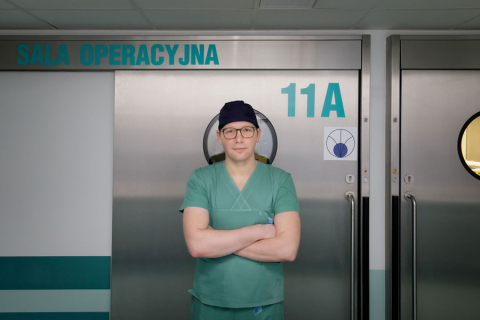The Chair and Department of General, Transplant and Liver Surgery UCC MUW is the largest liver transplantation center in Poland and one of the largest in the world. When was the first transplantation performed there?
The first successful liver transplantation at the Department was performed in 1994, and it was also the first successful liver transplantation in an adult in Poland. Since then, the Department's transplant program has grown steadily, leading to a record number of more than 180 transplants performed in 2014 alone.
What are the indications for transplantation of this organ?
Liver transplantation is the only effective treatment for patients with chronic liver failure and acute liver failure, where the availability of a donor often determines the patient's survival. In recent years, a number of different malignancies have been included among the recognized indications for liver transplantation, which has led to the emergence of another branch of medicine known as transplant oncology. Currently, liver transplantation can be considered in selected patients with hepatocellular carcinoma, extrahepatic bile duct cancer, metastatic neuroendocrine tumors, tumors originating from the vascular endothelium or even metastatic colorectal cancer.
According to the data of the Transplant Organizing and Coordinating Center "Poltransplant", in September this year 157 people were waiting for liver transplantation, a year earlier 119. Why is the number of waiting patients increasing?
Because of the increasing number of indications for transplantation. This has led to a growing disparity between the demand for liver transplantation treatment and the number of available donors. This phenomenon of a relative but extremely significant shortage of organs is widespread around the world and is the greatest constraint on the further development of this method of treatment. It is worth noting here that despite the limited number of donors, 2626 liver transplants have been performed to date in the Department of General, Transplant and Liver Surgery.
This is a large number, how is the department dealing with the organ shortage phenomenon today?
Since 1999, the Department's team has been cooperating with the Department of Pediatric Surgery and Organ Transplantation Children's Memorial Health Institute, headed by Prof. Piotr Kaliciński, by collecting liver fragments from living donors for children. The degree of cooperation is evidenced by the number of liver fragment donations performed so far - 449 – It represents the best response to the insufficient number of organs taken from deceased donors, especially for children. With regard to increasing number of organs available for adult recipients, a program of perfusion of harvested livers in hypothermia with oxygenation has been started at our Department. Performing this procedure allows us to reduce the damage associated with ischemia and the subsequent restoration of liver blood flow, a phenomenon that underlies the failure of the transplanted organ to resume function. Using hypothermic perfusion, we are able to safely utilize more organs by utilizing those that would otherwise have too many risks.
Increasing the pool of available organs remains our top priority. In the face of a donor shortage, performing each additional transplant saves a patient who would otherwise have no chance of long-term survival. In short, increasing the number of transplants by 20 per year avoids the death of 20 patients in the population. One way is to split one organ for two recipients (split liver transplantation). Such a procedure is possible in the case of an adequate liver mass taken from a deceased donor in the absence of significant risk factors for non-function. The Department plans to perform the first split organ transplants later this year. As with children, it is possible to use liver fragments taken from living donors for adult recipients. The priority here is, of course, donor safety. Next year, it is planned to start transplanting left liver segments from living donors, the harvesting of which is associated with significantly lower risks compared to the harvesting of right ones.
